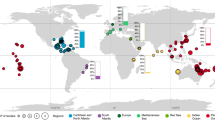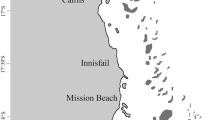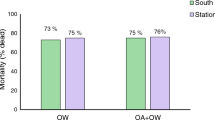Abstract
As sea surface temperatures increase worldwide due to climate change, coral bleaching events are becoming more frequent and severe, resulting in reef degradation. Leveraging the inherent ability of reef-building corals to acclimatize to thermal stress via pre-exposure to protective temperature treatments may become an important tool in improving the resilience of coral reefs to rapid environmental change. We investigated whether historical bleaching phenotype, coral host genotype, and exposure to protective temperature treatments would affect the response of the Hawaiian coral Montipora capitata to natural thermal stress. Fragments were collected from colonies that demonstrated different bleaching responses during the 2014–2015 event in Kāne‘ohe Bay (O‘ahu, Hawai‘i) and exposed to four different artificial temperature pre-treatments (and a control at ambient temperature). After recovery, fragments experienced a natural thermal stress event either in laboratory conditions or their native reef environment. Response to thermal stress was quantified by measuring changes in the algal symbionts’ photochemical efficiency, community composition, and relative density. Historical bleaching phenotype was reflected in stable differences in symbiont community composition, with historically bleached corals containing only Cladocopium symbionts and historically non-bleached corals having mixed symbiont communities dominated by Durusdinium. Mixed-community corals lost more Cladocopium than Cladocopium-only corals during the natural thermal stress event and preferentially recovered with Durusdinium. Laboratory pre-treatments exposed corals to more thermal stress than anticipated, causing photochemical damage that varied significantly by genotype. While none of the treatments had a protective effect, temperature variation during treatments had a significant detrimental effect on photochemical efficiency during the thermal stress event. These results show that acclimatization potential is affected by fine-scale differences in temperature regime, host genotype, and relatively stable differences in symbiont community composition that underpin historical bleaching phenotypes in M. capitata.






Similar content being viewed by others
Data availability
All raw data and code are available on Zenodo at https://doi.org/10.5281/zenodo.3946512
References
Ainsworth TD, Heron SF, Ortiz JC, Mumby PJ, Grech A, Ogawa D, Eakin CM, Leggat (2016) Climate change disables coral bleaching protection on the Great Barrier Reef. Science 352:338–342
Bahr KD, Jokiel PL, Rodgers KS (2015) The 2014 coral bleaching and freshwater flood events in Kaneohe Bay Hawaii. PeerJ 3:e950
Bahr KD, Jokiel PL, Toonen RJ (2015) The unnatural history of Kaneohe Bay: coral reef resilience in the face of centuries of anthropogenic impacts. PeerJ 3:e1136
Bahr KD, Rodgers KS, Jokiel PL (2017) Impact of three bleaching events on the reef resiliency of Kaneohe Bay Hawaii. Front Mar Sci 4:398
Baker AC (2003) Flexibility and specificity in coral-algal symbiosis: diversity, ecology, and biogeography of Symbiodinium. Annu Rev Ecol Evol S 34:661–689
Baker DM, Andras JP, Jordán-Garza AG, Fogel ML (2013) Nitrate competition in a coral symbiosis varies with temperature among Symbiodinium clades. ISME J 7:1248–1251
Bay RA, Palumbi SR (2015) Rapid acclimatization ability mediated by transcriptome changes in reef-building corals. Genome Biol Evol 7:1602–1612
Bay LK, Doyle J, Logan M, Berkelmans R (2016) Recovery from bleaching is mediated by threshold densities of background thermo-tolerant symbiont types in a reef-building coral. R Soc Open Sci 3:160322
Bay RA, Rose NH, Logan CA, Palumbi SR (2017) Genomic models predict successful adaptation if future warming rates are reduced. Sci Adv 3:e1701413
Bellantuono AJ, Hoegh-Guldberg O, Rodriguez-Lanetty M (2012) Resistance to thermal stress in corals without changes in symbiont composition. Proc R Soc B 279:1100–1107
Bellantuono AJ, Granados-Cifuentes C, Miller DJ, Hoegh-Guldberg O, Rodriguez-Lanetty M (2012) Coral thermal tolerance: tuning gene expression to resist thermal stress. PLoS ONE 7:e50685
Berkelmans R, van Oppen MJH (2006) The role of zooxanthellae in the thermal tolerance of corals: a’nugget of hope’ for coral reefs in an era of climate change. Proc R Soc B 273:2305–2312
Brown BE, Dunne RP, Edwards AJ, Sweet MJ, Phongsuwan N (2015) Decadal environmental’memory’ in a reef coral? Mar Biol 162:479–483
Cantin NE, van Oppen MJH, Willis BL, Mieog JC, Negri AP (2009) Juvenile corals can acquire more carbon from high-performance algal symbionts. Coral Reefs 28:405–415
Chevin LM, Lande R, Mace GM (2010) Adaptation, plasticity, and extinction in a changing environment: towards a predictive theory. PLoS Biol 8:e1000357
Coles SL, Jokiel PL, Lewis CR (1976) Thermal tolerance in tropical versus subtropical Pacific reef corals. Pac Sci 30:159–166
Connell JH (1978) Diversity in tropical rain forests and coral reefs. Science 199:1302–1310
Császár NBM, Ralph PJ, Frankham R, Berkelmans R, van Oppen MJH (2010) Estimating the potential for adaptation of corals to climate warming. PLoS ONE 5:e9751
Cunning R, Baker AC (2013) Excess algal symbionts increase the susceptibility of reef corals to bleaching. Nat Clim Change 3:259–262
Cunning R, Silverstein RN, Baker AC (2015a) Investigating the causes and consequences of symbiont shuffling in a multi-partner reef coral symbiosis under environmental change. Proc R Soc B 282:1–8
Cunning R, Gilette P, Capo T, Galvez K, Baker AC (2015b) Growth tradeoffs associated with thermotolerant symbionts in the coral Pocillopora damicornis are lost in warmer oceans. Coral Reefs 34:155–160
Cunning R, Ritson-Williams R, Gates RD (2016) Patterns of bleaching and recovery of Montipora capitata in Kaneohe Bay, Hawaii, USA. Mar Ecol Prog Ser 551:131–139
Cunning R, Silverstein RN, Baker AC (2018) Symbiont shuffling linked to differential photochemical dynamics of Symbiodinium in three Caribbean reef corals. Coral Reefs 37(1):145–152
Dixon GB, Davies SW, Aglyamova GV, Meyer E, Bay LK, Matz MV (2015) Genomic determinants of coral heat tolerance across latitudes. Science 348:1460–1462
Drury C (2019) Resilience in reef-building corals: Thermal stress and the influence of host genotype and phenotype. Mol Ecol 29:448–465
Drury C, Manzello D, Lirman D (2017) Genotype and local environment dynamically influence growth, disturbance response and survivorship in the threatened coral. Acropora cervicornis PloS One 12:e0174000
Glynn PW (1993) Coral reef bleaching: ecological perspectives. Coral Reefs 12:1–17
Glynn PW (1996) Coral reef bleaching: facts, hypotheses and implications. Glob Change Biol 2:495–509
Hoegh-Guldberg O, Mumby PJ, Hooten AJ, Steneck PRS, Greenfield P, Gomez E, Harvell CD, Sale PF, Edwards AJ, Caldeira K, Knowlton N, Eakin CM, Iglesias-Prieto R, Muthiga N, Bradbury RH, Dubi A, Hatziolos ME (2007) Coral reefs under rapid climate change and ocean acidification. Science 318:1737–1742
Hughes TP, Baird AH, Bellwood DR, Card M, Connolly SR, Folke C, Grosberg R, Hoegh-Guldberg O, Jackson JBC, Kleypas J, Lough JM, Marshall P, Nyström M, Palumbi SR, Pandolfi JM, Rosen B, Roughgarden J (2003) Climate change, human impacts, and the resilience of coral reefs. Science 301:929–933
Innis T, Cunning R, Ritson-Williams R, Wall CB, Gates RD (2018) Coral color and depth drive symbiosis ecology of Montipora capitata in Kaneohe Bay, Oahu. Hawaii Coral Reefs 37:423–430
Jones A, Berkelmans R (2010) Potential costs of acclimatization to a warmer climate: growth of a reef coral with heat tolerant vs. sensitive symbiont types. PLoS ONE 5:e10437
Jones RJ, Ward S, Amri AY, Hoegh-Guldberg O (2000) Changes in quantum efficiency of Photosystem II of dinoflagellates of corals after heat stress, and of bleached corals sampled after the 1998 Great Barrier Reef mass bleaching event. Mar Freshwater Res 51:63–71
Jury CP, Toonen RJ (2019) Adaptive responses and local stressor mitigation drive coral resilience in warmer, more acidic oceans. Proc R Soc B 286:20190614
LaJeunesse TC, Parkinson JE, Gabrielson PW, Jeong HJ, Reimer JD, Voolstra CR, Santos SR (2018) Systematic revision of Symbiodiniaceae highlights the antiquity and diversity of coral endosymbionts. Curr Biol 28:2570–2580
Lesser MP (2006) Oxidative stress in marine environments: biochemistry and physiological ecology. Annu Rev Physiol 68:253–278
Matsuda S, Huffmyer AS, Lenz EA, Davidson JM, Hancock JR, Przybylowski A, Innis T, Gates RD, Barott KL (2020) Coral bleaching susceptibility is predictive of subsequent mortality within but not between coral species. Front Ecol Evol 8:178
Matz MV, Treml EA, Aglyamova GV, Bay LK (2018) Potential and limits for rapid genetic adaptation to warming in a Great Barrier Reef coral. PLoS Gen 14:e1007220
Matz MV, Treml EA, Haller BC (2020) Estimating the potential for coral adaptation to global warming across the Indo-Pacific. Glob Chang Biol 26:3473–3481
Maynard JA, Anthony KRN, Marshall PA, Masiri I (2008) Major bleaching events can lead to increased thermal tolerance in corals. Mar Biol 155:173–182
McGinley MP, Aschaffenburg MD, Pettay DT, Smith RT, LaJeunesse TC, Warner ME (2012) Symbiodinium spp. in colonies of eastern Pacific Pocillopora spp. are highly stable despite the prevalence of low-abundance background populations. Mar Ecol Prog Ser 462:1–7
McIlroy SE, Cunning R, Baker AC, Coffroth MA (2019) Competition and succession among coral endosymbionts. Ecol Evol 9:12767–12778
Middlebrook R, Hoegh-Guldberg O, Leggat W (2008) The effect of thermal history on the susceptibility of reef-building corals to thermal stress. J Exp Biol 211:1050–1056
Mieog JC, van Oppen MJH, Berkelmans R, Stam WT, Olsen JL (2009) Quantification of algal endosymbionts (Symbiodinium) in coral tissue using real-time PCR. Mol Ecol Resour 9:74–82
National Oceanic and Atmospheric Administration. National Environmental Satellite, Data, and Information Service Coral Reef Watch. https://coralreefwatch.noaa.gov/satellite/dhw.php
National Oceanic and Atmospheric Administration. National Data Buoy Center, Station MOKH1. https://www.ndbc.noaa.gov/view_climplot.php?station=mokh1&meas=st
Palumbi SR, Barshis DJ, Traylor-Knowles N, Bay RA (2014) Mechanisms of reef coral resistance to future climate change. Science 344:895–898
Pandolfi JM, Bradbury RH, Sala E, Hughes TP, Bjorndal KA, Cooke RG, McArdle D, McClenachan L, Newman MJH, Paredes G, Warner RR, Jackson JBC (2003) Global trajectories of the long-term decline of coral reef ecosystems. Science 301:955–958
Putnam HM, Edmunds PJ (2010) The physiological response of reef corals to diel fluctuations in seawater temperature. J Exp Mar Biol Ecol 396:216–223
Putnam HM, Gates RD (2015) Preconditioning in the reef-building coral Pocillopora damicornis and the potential for trans-generational acclimatization in coral larvae under future climate change conditions. J Exp Biol 218:2365–2372
Quigley KM, Willis BL, Bay LK (2017) Heritability of the Symbiodinium community in vertically- and horizontally-transmitting broadcast spawning corals. Sci Rep 7:8219
Quigley KM, Bay LK, Willis BL (2018) Leveraging new knowledge of Symbiodinium community regulation in corals for conservation and reef restoration. Mar Ecol Prog Ser 600:245–253
Quigley KM, Bay LK, van Oppen MJH (2020) Genome-wide SNP analysis reveals an increase in adaptive genetic variation through selective breeding of coral. Mol Ecol 29:2176–2188
Ritson-Williams R, Gates RD (2020) Coral community resilience to successive years of bleaching in Kaneohe Bay. Hawaii Coral Reefs 39:757–769
RStudio Team (2015) RStudio: Integrated development for R. RStudio, Inc. http://www.rstudio.com/
Roach TNF, Dilworth J, Martin HC, Jones AD, Quinn R, Drury C (2020) Metabolomic signatures of coral bleaching history. BioRxiv. https://doi.org/10.1101/2020.05.10.087072
Rowan R (2004) Thermal adaptation in reef coral symbionts. Nature 430:742
Ruiz-Jones LJ, Palumbi SR (2017) Tidal heat pulses on a reef trigger a fine-tuned transcriptional response in corals to maintain homeostasis. Sci Adv 3:e1601298
Schoepf V, Carrion SA, Pfeifer SM, Naugle M, Dugal L, Bruyn J, McCulloch MT (2019) Stress-resistant corals may not acclimatize to ocean warming but maintain heat tolerance under cooler temperatures. Nat Comm 10:4031
Silverstein RN, Cunning R, Baker AC (2014) Change in algal symbiont communities after bleaching, not prior heat exposure, increases heat tolerance of reef corals. Glob Change Biol 21:236–249
Tansik AL, Fitt WK, Hopkinson BM (2017) Inorganic carbon in scarce for symbionts in scleractinian corals. Limnol Oceanogr 62:2045–2055
Torda G, Donelson JM, Aranda M, Barshis DJ, Bay L, Berumen ML, Bourne DG, Cantin N, Foret S, Matz M (2017) Rapid adaptive responses to climate change in corals. Nat Clim Change 7:627
van Hooidonk R, Maynard JA, Planes S (2013) Temporary refugia for coral reefs in a warming world. Nat Clim Change 3:508–511
van Hooidonk R, Maynard JA, Manzello D, Planes S (2014) Opposite latitudinal gradients in projected ocean acidification and bleaching impacts on coral reefs. Glob Change Biol 20:103–112
van Oppen MJH, Oliver JK, Putnam HM, Gates RD (2015) Building coral reef resilience through assisted evolution. P Natl Acad Sci USA 112:2307–2313
Wall CB, Ritson-Williams R, Popp BN, Gates RD (2019) Spatial variation in the biochemical and isotopic composition of corals during bleaching and recovery. Limnol Oceanogr 64:2011–2028
Wangpraseurt D, Pernice M, Guagliardo P, Kilburn MR, Clode PL, Polerecky L, Kühl M (2015) Light microenvironment and single-cell gradients of carbon fixation in tissues of symbiont-bearing corals. ISME J 10:788–792
Warner ME, Fitt WK, Schmidt GW (1999) Damage to photosystem II in symbiotic dinoflagellates: a determinant of coral bleaching. Proc Natl Acad Sci USA 96:8007–8012
Weis VM (2008) Cellular mechanisms of Cnidarian bleaching: stress causes the collapse of symbiosis. J Exp Biol 211:3059–3066
Wyatt ASJ, Leichter JJ, Toth LT, Miyajima T, Aronson RB, Nagata T (2019) Heat accumulation on coral reefs mitigated by internal waves. Nat Geosci 13:28–34
Acknowledgements
We thank Nina Bean, Luke Kikukawa, Shayle Matsuda, Josh Hancock, Joel Huckeba, Ariana Huffmyer, Ty Roach, Mariana Rocha de Souza, and the Gates Coral Lab for their assistance with this project. Ruth Gates’ vision for a better future for coral reefs inspired this work. This work was funded by the Paul G. Allen Family Foundation and formed part of JD’s Master’s thesis at the University of Miami. This is HIMB contribution 1833 and SOEST contribution 11180.
Author information
Authors and Affiliations
Contributions
JD, CD, and CC conceptualized the experiment. JD, VAK, CD, and CC collected data. JD analyzed data with assistance from CD and ACB. JD, CD, and ACB interpreted the data. JD wrote the manuscript. All authors edited and approved the final version.
Corresponding author
Ethics declarations
Conflict of interest
We declare no competing interests.
Additional information
Publisher's Note
Springer Nature remains neutral with regard to jurisdictional claims in published maps and institutional affiliations.
Topic Editor Carly Kenkel
Electronic supplementary material
Below is the link to the electronic supplementary material.
Rights and permissions
About this article
Cite this article
Dilworth, J., Caruso, C., Kahkejian, V.A. et al. Host genotype and stable differences in algal symbiont communities explain patterns of thermal stress response of Montipora capitata following thermal pre-exposure and across multiple bleaching events. Coral Reefs 40, 151–163 (2021). https://doi.org/10.1007/s00338-020-02024-3
Received:
Accepted:
Published:
Issue Date:
DOI: https://doi.org/10.1007/s00338-020-02024-3




